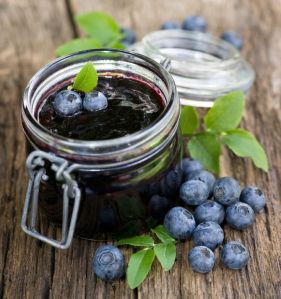This week’s SuperFood spotlight falls on the simple BLUEBERRY. As such a common berry, it may seem challenging to believe that this familiar fruit can pack such a bio-active punch. Dr. Steven Pratt, M.D., touts blueberries as THE most powerful disease-fighting antioxidant of all fruits and vegetables. This is not measured in one singular aspect of the blueberry but in its broad spectrum of extraordinarily powerful ingredients. Blueberries are native to North America and were used by the Native Americans to treat digestive ailments and to reduce pain in childbirth. This goes beyond “wives’ tale” treatments, it has the power of science behind it. Blueberries contain pectin which aids intestinal irregularities, the polyphenols have been studied as antibacterials for digestive bacteria, and the berry also contains salicylic acid (a metabolite of aspirin) which is an effective anti-inflammatory and pain reliever.
Blueberries contain at least 5 different types of anthocyanins, which are the pigments that are responsible for the red, purple, and blue colors of many vegetables, fruits, grains, and flowers. Anthocyanins are part of a group of naturally occurring plant chemicals called flavonoids. Flavonoids have become widely studied and accepted by the scientific and medical community as powerful disease fighters. Research continues to identify the pathway that these powerhouses use to prevent and repair DNA damage which is a critical aspect of disease. However, anthocyanins are only one of the active phytonutrients in blueberries. A 2/3 cup serving of this SuperFood lends the same antioxidant values as 1,733 IU of vitamin E, and 1,200 mg of vitamin C.
Blueberries can have an ORAC score (oxygen radical absorption capacity – ability to neutralize free-radicals that cause disease & speed aging) of up to 13,427 units. What does that mean for you? Free-radicals are the highly reactive agents in our bodies that can cause cell damage, DNA damage, and are key contributors to degenerative diseases (Alzheimer’s, arthritis, etc), as well as to cancer, heart disease, and the aging process itself. Some free-radicals occur during normal metabolism and when antioxidants are available from our diet, these perpetrators are easily neutralized. However, in today’s world, our bodies encounter free-radicals from a multitude of sources including pollution, radiation, cigarette smoke, pesticides, herbicides, damaging UV rays from the sun, and unfortunately many other sources. When the supply of anti-oxidants, which bind and neutralize the free-radicals, is not sufficient, the free-radicals attack our healthy cells and disease or degradation is born. An ORAC score of is an indication of a dietary source’s free-radical destroying potential.
There have been numerous clinical studies by a multitude of universities and research centers that clearly shows the connection between a broad spectrum of antioxidants, especially from food sources (vs supplements), and the decrease in heart disease, Alzheimer’s, diabetes, degenerative diseases, and a reduced risk of cancer. In addition, Tufts University’s USDA Human Nutrition Research Center on Aging, published their Blueberry study results which indicated that these super berries slowed and even reversed some of the shattering effects of Alzheimer’s, and continued research has shown that blueberries have an anti-inflammatory brain and muscle effect.
It’s important to remember that it is not the blueberry’s ORAC score, its antioxidant value, or its vitamin content alone that rate it as a SuperFood, but it’s the entire spectrum of bioactive nutrients that work together making it powerful in its own right, as well as a synergist that increases the effectiveness of another substance or cell. This is also the reason that dietary sources of nutrients are more effective and more powerful than nutritional supplements (according to a Harvard study). This does not mean that supplements are not useful, but food sources are always the best choice.
It’s now blueberry season in many parts of the United States, therefore these wonderful fruits are not only widely available but also very affordable. Blueberries contain all of the following nutrients and 1 cup contains only 85 calories: 3.6 g fiber, 1.1 g protein, anthocyanins, ellagic acid (research shows those who consume this acid are 3 times less likely to get cancer), quercetin (antioxidant), catechins (antioxidants), salicylic acid, carotenoids (antioxidants), folate, vitamin C, vitamin E, potassium, manganese, magnesium, iron, riboflavin, niacin, and phytoestrogens. Find your blueberry thrill today!


The other beauty of this food is that the blueberry is the rare exception to my belief that the worse something tastes, the better it is for your health 🙂 They’re yummy!